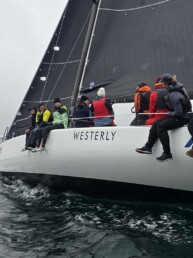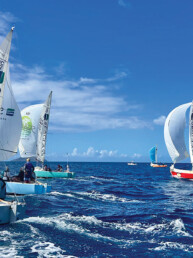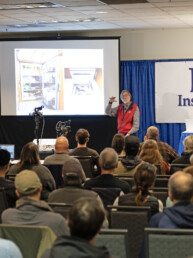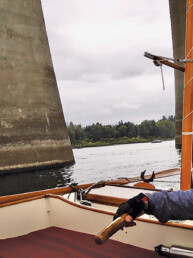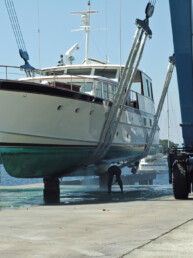The Gorge delivers for Optimist Nationals!
When I told people in 2019 that the Columbia Gorge Racing Association (CGRA) was thinking about putting in a bid for the USODA Opti Nationals, I got a lot of responses, usually ranging between shocked and skeptical. CGRA prides itself on running world class events, and has a long list of national, continental, and world championships under its belt, but this was arguably the most ambitious event we had taken on in a decade. An Opti Nationals can draw up to 300 boats, but it’s not just the competitors, it’s the entourage of parents, siblings, coaches, vendors, and the army of volunteers that can easily triple the total number of people in attendance.
Before we ever got to the point of submitting a bid, I asked Erin Timms if she would serve as regatta chair. During the regatta I would be busy coaching. I could serve as CGRA’s regatta representative and lead the planning process, but we needed a capable and talented chair to manage the event while it was underway. Erin has more than a decade of experience attending USODA events with her sons Owen and Alan. The term “Opti mom” might get a bad wrap in some circles, but in Erin’s case she proudly uses the title. Fortunately, she called my bluff, and by early 2020 we shipped our bid off to USODA, with strong encouragement from USODA Executive Director Beth Danilek. Then of course, the pandemic hit and everything ground to a halt. Our bid was eventually accepted, but postponed a year until July 2022. We were bummed, but in hindsight, the extra year of preparation was greatly appreciated.
The Zoom meetings began in fall of 2021. As key personnel were confirmed, our Zoom meetings grew to include Eric Rimkus (PRO), Craig Daniels (Chief Judge), and Susan Winner, who decided to stay on one more year as CGRA Events Manager. The logistics were daunting. We needed about 40 on-water volunteers, housing for 10 judges and half a dozen VIPs, 15 race committee/support boats, moorage for 20+ coach boats, plus space for vendors, not to mention all of the Optis! Although an Opti is only 7 ½’ long, when there are 170 of them, they take up a lot of space! We actually really lucked out that we didn’t exceed 220 participants, as we would have probably broken the venue (and our volunteers). Most of us involved with planning had at least a few sleepless nights thinking about all of the things that could go wrong.
Our expectations for the event were high. We had promised visitors no-frills racing in a spectacular venue. CGRA isn’t a yacht club and has just two part-time employees. Even at the largest regattas, CGRA relies almost exclusively on volunteers and dedicated board members to do the heavy lifting. Instead of restrooms with hot towels and lotion dispensers, we get by with a row of port-a-potties in the parking lot. It’s the consistently strong westerly winds and excellent race management that we wanted to highlight. We also encouraged visiting families to make this regatta their summer vacation and to spend time exploring the Gorge when not racing. Many families ended up staying in the Gorge for ten days or more. With 500 people in town for the better part of two weeks, the economy of Cascade Locks enjoyed a significant bump, which hopefully offset any feelings of encroachment in a town with 1,100 residents.
Nationals was preceded by the annual WIND Clinic and WIND Regatta a week earlier. Both had a special flavor with dozens Opti sailors from around the country arriving early to train. WIND Clinic for both Lasers and Optis was sold-out with a record 110 sailors and 11 coaches total. A few days later, 65 Optis were packed on one starting line at WIND Regatta. WIND week ended up being a great training opportunity for the sailors and race committee! For me, I got to know a lot of our local Opti sailors better during WIND Clinic. At Nationals, I continued coaching these sailors from CYC Seattle, Olympia, Narrows, Willamette and Sail Sand Point as part of “Team Northwest.”
After the conclusion of WIND, the venue was officially “open.” By Tuesday, July 19 most everyone had arrived for Nationals. The river was full of teams out practicing, while others waited in line to measure in their equipment. For the sailors that did WIND, many opted to take a well deserved break to rest their legs, some even returned home to sleep in their bed for a night or two.
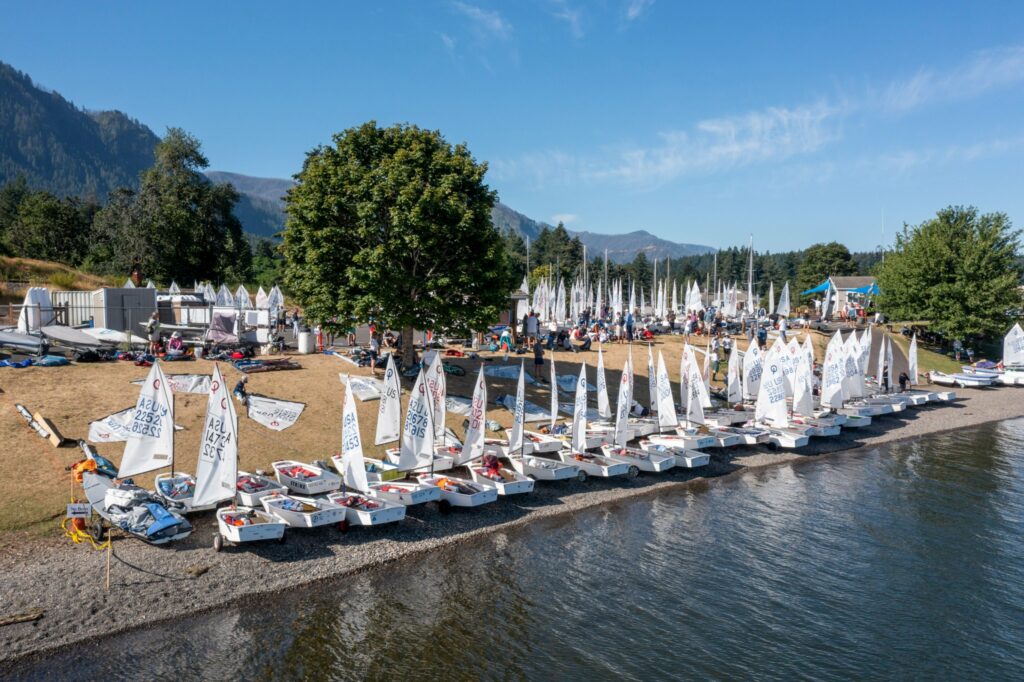
Racing opened on Wednesday, July 20 with a one-day Girls Nationals featuring 58 boats. With five races scheduled in one day, Girls Nationals can be grueling. By Gorge standards, the winds were pretty moderate, topping out just shy of 20 knots for the final two races. This was fortunate for the girls, as no one wanted to start the four-day open nationals on tired legs. Based on the forecast, a couple of our local girls decided to do Girls Nationals at the last minute, including 9-year old Reagan Starke.
To put it in perspective, Reagan had only done some local Green Fleet racing prior to this summer, and has spent most of her time sailing in the sheltered waters around Gig Harbor. Reagan gritted it out and finished all of her races on Wednesday, making her the youngest competitor to do so. She walked away from WIND and Nationals a completely transformed sailor with newfound confidence and determination. To some degree this happened to every member of Team Northwest, which goes to highlight the importance of sailing against good competition and in challenging conditions for days on end.
Open Nationals was scheduled for Thursday-Sunday, with three 40-50 minute races to be completed each day. The 150 boat championship fleet would be randomly divided into three heats for the first two days. At the halfway point, the fleet would then be broken into gold and silver divisions based on results from the first two days. On the line were USODA Team Trials invitations (top 50% of finishers) and a handful of berths to the South American continental championships in Rio this fall.
Those who didn’t attend WIND hadn’t really seen a big day on the river yet, and I even heard some competitors saying “it’s not actually that windy here.” The first day of Nationals was similar to the girls event the day before. The westerly wind oscillated back and forth with significant puffs and lulls, but never really exceeded 20 knots. Friday (Day 2) was a classic Gorge day that began with thick cloud cover to the west, cooler temperatures, and a brisk westerly. By mid-day the puffs were in the mid-20’s. There were big grins and lots of stories being told on the beach and in the boat park. PRO Eric Rimkus and his team made efficient work of the first six races and both days the competitors were back on the beach around 2:30pm. The judges kept the racing fair, were efficient with hearings, and issued a number of Rule 42 penalties on the water.
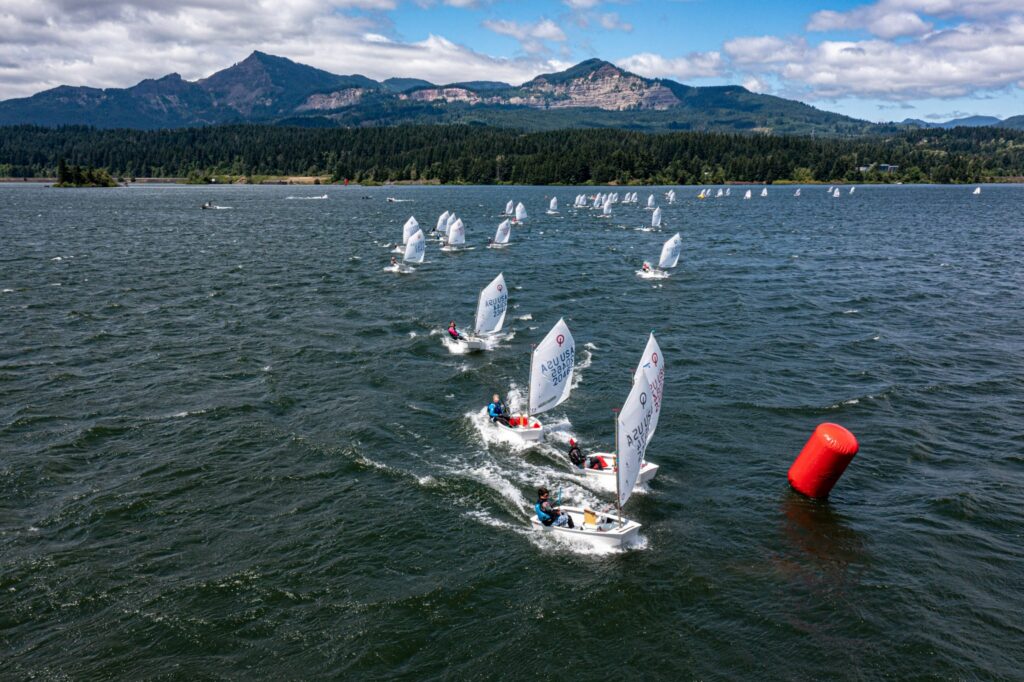
With rising temperatures predicted and uncertainty about Sunday’s forecast, Eric made the decision to run four races on Saturday. It turned out to be one of the most epic days I’ve ever seen on our stretch of river. Winds were sustained over 20 knots all day, with gusts over 30. A buoy a couple of miles upriver of the racecourse even recorded a 40 knot gust at one point. The river was running strong too, which made for three-foot standing waves in the channel near Stevenson. It was simply spectacular to watch some of the best Opti sailors in the country duke it out in these conditions. Silver was called off after three races, but gold division stayed out and completed all four races. Puffs near 30 were still buffeting the race office at 5pm, so we had to cancel Green Fleet that evening.
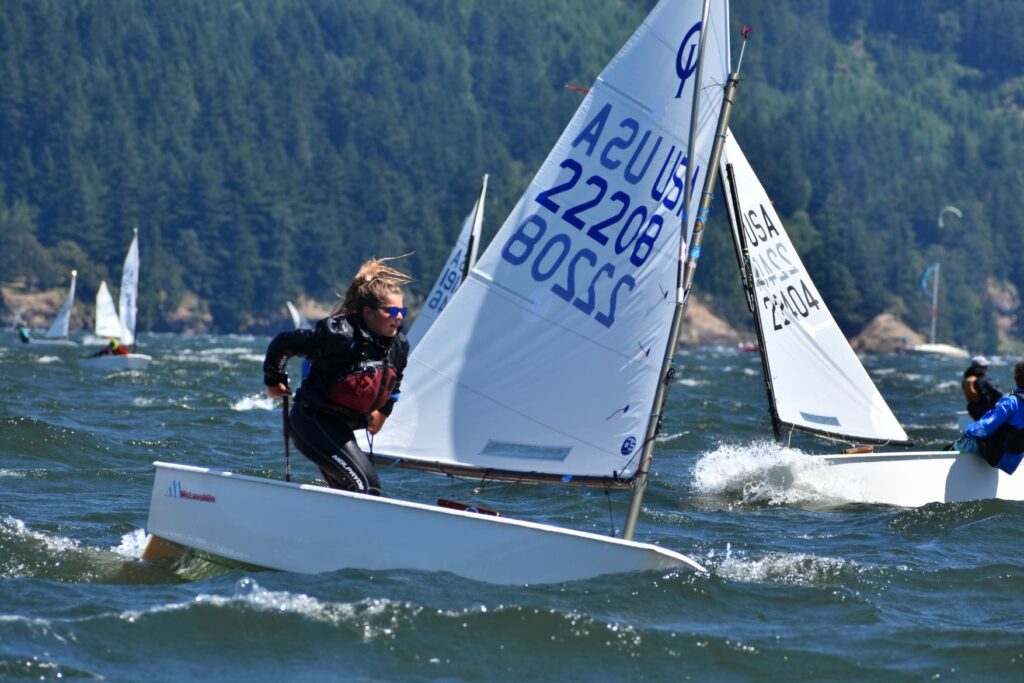
On the final day, the wind gods took pity on competitors. Racing got underway in a light westerly between 6-10 knots. No one was complaining. The Gorge had proven its point and earned everyone’s respect. With the light wind, competitors ended up being tested in a wide range of conditions throughout the four days. The end was bittersweet for local sailors Finn Deprez, Alan Timms, and Sebastian LeRoy who all stayed in the Opti an extra year so they could sail Nationals on their home turf. For them it was the end of an era, but for other Northwest sailors it was just the beginning. Most of the sailors I coached had never attended a national championship before. Although none qualified for gold fleet, it was a huge moment of growth and one that will likely have a big ripple effect on our region’s Opti scene.
When people knock the Opti, it’s usually for the wrong reasons. I hear people call them slow, stupid, archaic etc., but as is the case with other strong one-design classes, it’s more about regular access to high level competition in standardized equipment and less about whether you’re sailing the “best” design. And for all its quirks, the Opti has some good features. The gaff rig keeps the center of effort lower in the sail plan, sail ties teach attention to detail when rigging, and the flat bottom makes it stable (it’ll also plane!). I don’t think it’s any coincidence that most Olympians and world champions learn to race on “old stupid boats,” whether it’s an Opti, Sabot, or El Toro. Learn to make any of these designs go fast and you can sail anything!
Some have a negative association with the USODA as well, but we found working with the class association a pleasure and Executive Director Beth Danilek was always very supportive. The USODA has a lot of hosting requirements, but they do this to ensure events are well run and to protect their brand. It’s what strong class associations should do. And yes, there are parents who ruin the sport for their children (and others), but this is a culture problem, and not unique to the Opti or youth sailing. The truth of the matter is that the vast majority of parents were hugely supportive of the event. More than half of our volunteers were visiting parents. One family even decided to buy lunches for all of the volunteers for the entire week! In many instances, it’s the few bad apples that standout in our minds, when most parents are actually there with the right attitude.
The feedback from visiting families was overwhelmingly positive, with several saying this was the best Opti regatta they’d ever attended. Others promised to return for future events at the Gorge. Chicago Yacht Club coach Flor Cerutti had this to say, “The sailing conditions couldn’t be better and the sailing venue was perfect. Likewise, the people that were involved in the event made the biggest difference… All of them were super kind and helpful. Always with a super big smile and kind words. They made us feel as if we were at home.” For all of our efforts, the Gorge did its part and delivered.
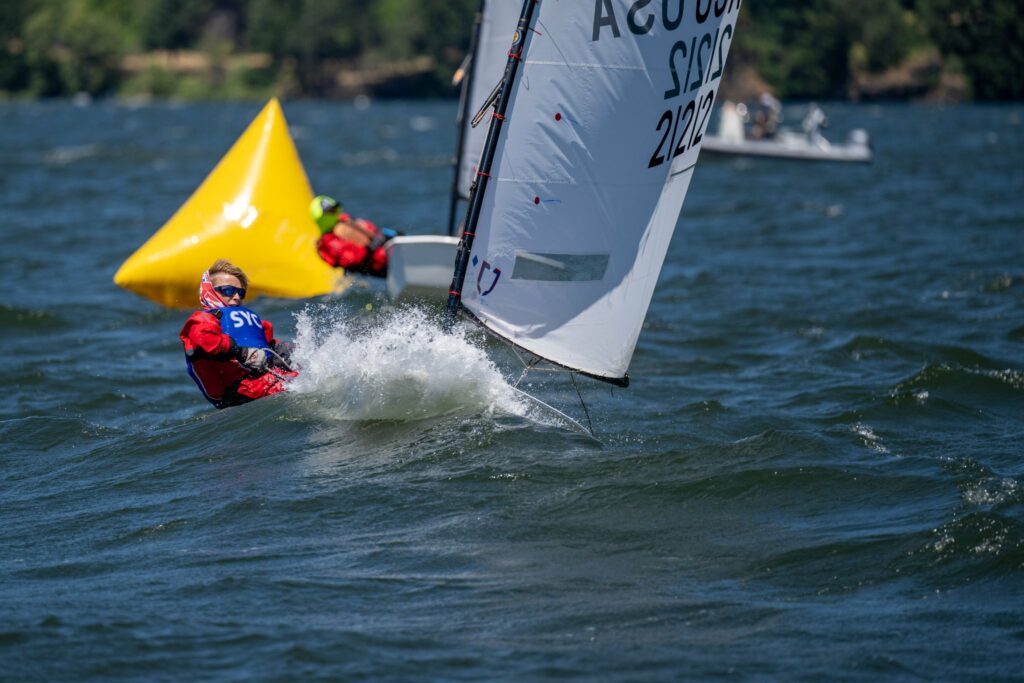
I’d like to once again thank all of the volunteers, parents, and partner organizations for making this event a huge success. These include the SYC Foundation (sponsor of the welcome dinner), The Sailing Foundation, Oregon Youth Sailing Foundation, Port of Cascade Locks, West Coast Sailing, and last but not least the USODA. Rose City Yacht Club, Willamette Sailing Club, Sail Sand Point, and Gig Harbor Jr. Sail also generously provided powerboats for our judge and support boat armada. It was truly a group effort!
Although it was asking a lot of our volunteers, neighbors, and partners, I would 100% do it again. I think it’s extremely important that we bring national and international championships to the Northwest whenever we have the opportunity to do so- not just for the benefit of our sailors, but also to disprove the notion that the Northwest is some backwater place to race sailboats. We have some amazing venues to showcase here in addition to the Gorge. We also have a lot of the necessary talent and infrastructure to pull off these events when we collaborate. My advice to anyone considering hosting a major championship is to just go for it!

